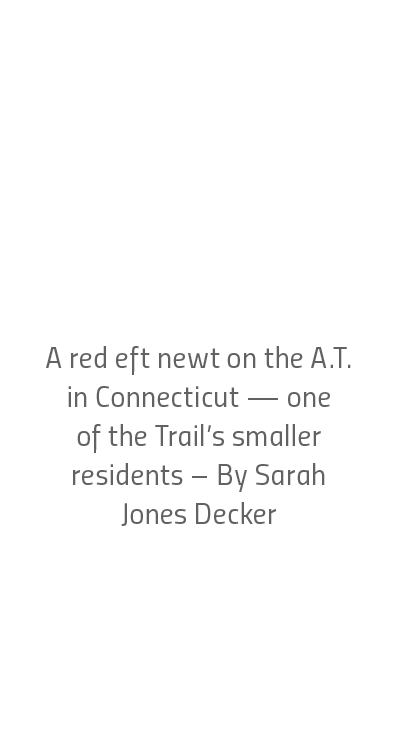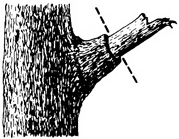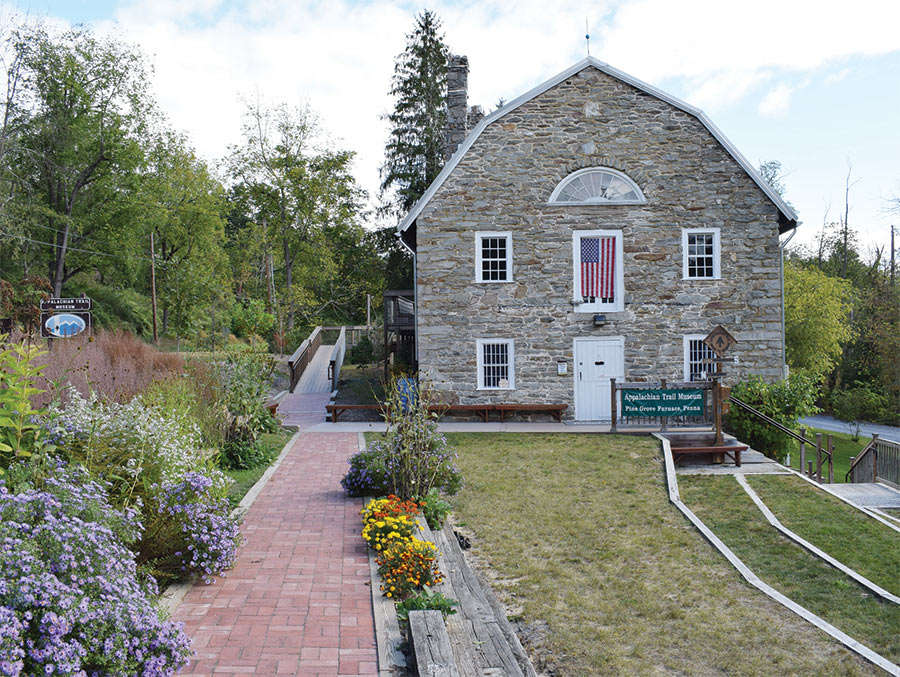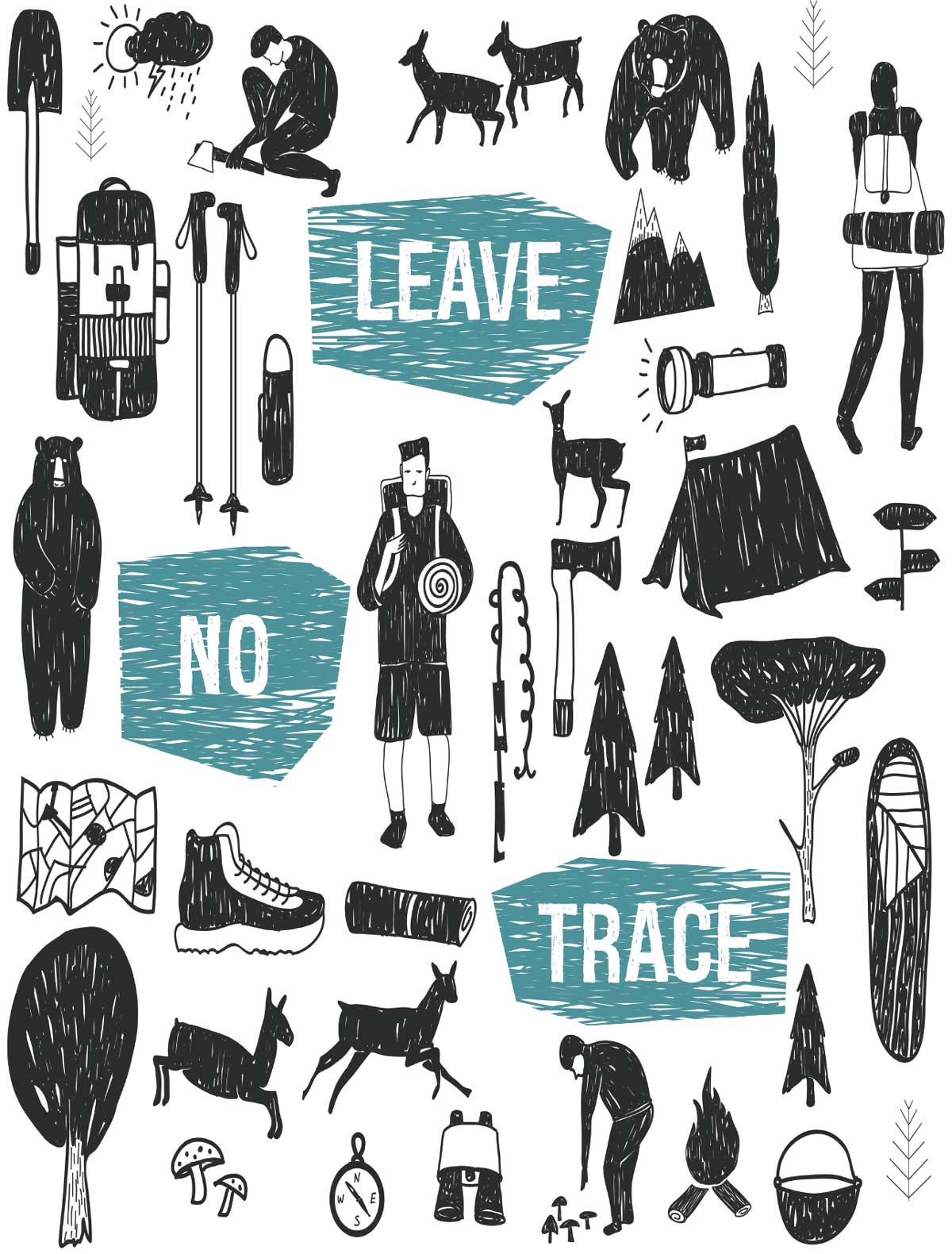ON THE COVER
Summer fun on Max Patch, North
Carolina/Tennessee – By Sarah Jones Decker
Above: Dragons Tooth is one of three popular destinations in the Catawba Mountain section of A.T. that is often referred to as the “Virginia Triple Crown” – By Garrett Fondoules
ON THE COVER
Summer fun on Max Patch, North
Carolina/Tennessee – By Sarah Jones Decker
Above: Dragons Tooth is one of three popular destinations in the Catawba Mountain section of A.T. that is often referred to as the “Virginia Triple Crown” – By Garrett Fondoules

Sandra Marra / President & CEO
Nicole Prorock / Chief Financial Officer
Shalin Desai / Vice President of Advancement
Laura Belleville / Vice President of Conservation & Trail Programs
Cherie A. Nikosey / Vice President of Administration
Brian B. King / Publisher & Archivist
Wendy K. Probst / Editor in Chief
Traci Anfuso-Young / Art Director / Designer
Jordan Bowman / Director of Communications
Laurie Potteiger / Information Services Manager
Brittany Jennings / Proofreader
The Appalachian Trail Conservancy’s mission is to protect, manage, and advocate for the Appalachian National Scenic Trail.
Colin Beasley / Chair
Robert Hutchinson / Vice Chair
Edward R. Guyot / Secretary
Jim LaTorre / Treasurer
Daniel A. Howe / Stewardship Council Chair
Grant Davies
Norman P. Findley
Thomas L. Gregg
Ann Heilman Murphy
Colleen Peterson
Nathan G. Rogers
Rubén Rosales
Ambreen Tariq
Hon. Stephanie Martz
Diana Christopulos
Jim Fetig
Lisa Koteen Gerchick
Mark Kent
R. Michael Leonard
Robert Rich
Hon. C. Stewart Verdery, Jr.
For membership questions or to become a member, call: (304) 885-0460
![]()
[email protected]
A.T. Journeys is published four times per year. Advertising revenues directly support the publication and production of the magazine, and help meet Appalachian Trail Conservancy objectives. For more information and advertising rates, visit: appalachiantrail.org/atjadvertising
The Appalachian Trail Conservancy’s mission is to protect, manage, and advocate for the Appalachian National Scenic Trail.
Colin Beasley / Chair
Robert Hutchinson / Vice Chair
Edward R. Guyot / Secretary
Jim LaTorre / Treasurer
Daniel A. Howe / Stewardship Council Chair
Grant Davies
Norman P. Findley
Thomas L. Gregg
Ann Heilman Murphy
Colleen Peterson
Nathan G. Rogers
Rubén Rosales
Ambreen Tariq
Hon. Stephanie Martz
Diana Christopulos
Jim Fetig
Lisa Koteen Gerchick
Mark Kent
R. Michael Leonard
Robert Rich
Hon. C. Stewart Verdery, Jr.
A.T. Journeys is published on Somerset matte paper manufactured by Sappi North America mills and distributors that follow responsible forestry practices. It is printed with Soy Seal certified ink in the U.S.A. by Sheridan NH in Hanover, New Hampshire.
A.T. Journeys ( ISSN 1556-2751) is published quarterly for $15 a year by the Appalachian Trail Conservancy, 799 Washington Street, Harpers Ferry, WV 25425, (304) 535-6331. Bulk-rate postage paid at Harpers Ferry, West Virginia, and other offices. Postmaster: Send change-of-address Form 3575 to A.T. Journeys, P.O. Box 807, Harpers Ferry, WV 25425.

~ Kathryn Herndon-Powell

I OFTEN REFER TO MY CO-WORKERS, A.T. VOLUNTEERS, AND ALL those who love the Trail and help to protect and advocate for it as a “force of nature.” This is perfectly apropos for a dynamic group of people who are deeply devoted to keeping the Appalachian Trail Conservancy’s message and the core story of the Appalachian Trail strong, relevant, and resilient. This is the message we strived to create in an issue that focusses on the complexity of the Trail experience — and the myriad visitors who seek it. Their voices, art, and photography — along with so many others who work behind the scenes — are genuine, strong, and expressive. These are the people who, along with our dedicated members, not only preserve the A.T. experience but are constantly working to make that experience and story one that anyone — in whatever form they love or embrace the Trail — can experience it at its best.

Sarah Jones Decker
Sarah “Harvest” Jones Decker is a Virginia native who started hiking the A.T. in her teens. She thru-hiked in 2008 and hiked the Trail again in sections in 2018-2019 for her book, The Appalachian Trail: Backcountry Shelters, Lean-tos, and Huts. She has her MFA in Photography from Savannah College of Art & Design and a BA in Journalism and Creative Writing from Virginia Tech. Sarah and her husband own an organic farm south of the Trail town of Hot Springs, North Carolina.
“As both a thru-hiker and section-hiker, it was hard to pick one single Trail experience to write about,” she says. (Trail Stories page 42) “In my brainstorming, I kept coming back to a quote I love by Greek philosopher, Heraclitus, ‘No man ever steps in the same river twice, for it’s not the same river and he’s not the same man.’ This could be said for our beloved Trail. It is always changing and we are changed because of it.”

Deidra Goodwin
Appalachian Trail Conservancy Next Generation Advisory Council member, Deidra Goodwin, has a background in facilitation and experiential education. Always balancing a passion for outdoor recreation and conservation, Deidra’s next steps will be pursuit of a masters degree in experiential education. With that, she plans to take her passion for experiences and the outdoors to continue to support as many people as possible in finding their personal definition of “outdoorsy.”
“One thing that I have experienced over the years is how often people tend to doubt themselves,” she says. “Writing this article about my take on the A.T. ‘Engagement Spectrum’ (page 34) was especially important to me because it gave me a platform to continue the narrative I’m trying to build for myself and everyone I encounter. There are so many ways to do life that we cheat ourselves by not giving our own way enough credit.”

Kathryn Herndon-Powell
A resident of Roanoke, Virginia, Kathryn Herndon-Powell has been the education and outreach coordinator for Appalachian Trail Conservancy’s Virginia regional office since 2013. “The Trail’s ability to connect never ceases to inspire me,” she says. “It connects us to nature and the land, but it also connects us to each other. I consider it a privilege to work with the dedicated volunteers and agency partners whose behind-the-scenes work makes this world-class hiking experience possible. Community and partnership are in the Trail’s DNA, and the successes of the McAfee Knob Task Force are one of the best examples I’ve seen of how powerful we are when we work together.” (page 22) Kathryn and her wife Susan have both thru-hiked the A.T., and welcomed their son Nash to the family in December. While in quarantine, they’ve been pointing out McAfee Knob’s graceful curve on the horizon as seen from their back deck. They hope to take him on his first hike there soon.

Andrew Downs
Andrew Downs, a North Carolinian living in Roanoke, Virginia, serves as the Appalachian Trail Conservancy’s (ATC) senior regional director in the central southwest region. After a 2002 thru-hike, a 2005 season as a backcountry naturalist at the Appalachian Mountain Club’s Greenleaf Hut, and graduate studies in the Great Smoky Mountains with North Carolina State University, Andrew began work with the ATC in January 2007. Reflections on his adventure as a thru-hiker led to a recognition that his experience might not have always been a good thing for other hikers, or for the A.T. itself. “I had a life-changing experience on the A.T., but I might not have been as thoughtful as I should have been about how I impacted other visitors and the resource itself,” he says. “That life-changing hike and a desire to make the Trail a better place for all has led me to a career serving the Trail and protecting the one and only A.T. experience.” (page 12)
President’s Letter
The theme of this issue centers on the Appalachian Trail experience. We’ve talked about the Trail experience for years, so it is not necessarily a new topic. But the lens by which we look at this theme, and the context in which it needs to be considered, has changed drastically and, perhaps, permanently.
First, we must now look at the Trail experience in the reality of a global pandemic. For the first time ever, the Appalachian Trail Conservancy (ATC) asked people to not hike on the A.T. In mid-March, we asked thru-hikers to leave the Trail if they had already started and we asked all others to postpone their start. This was followed by a plea to all visitors to stay off the Trail. This guidance was based on science and facts and took into consideration both human safety and resource protection. As I write this today, we are just now offering advice on how safe day use can be undertaken. We also are still waiting for approval from the National Park Service to let our volunteers return to the Trail. And we continue to struggle on how to advise long-distance hikers how to safely traverse the length of the Trail considering all the communities and states the A.T. passes through.

FIRST, LET ME TELL YOU HOW much I enjoy A.T. Journeys. I look forward to it each quarter and read it cover to cover, before sharing it with my son (and fellow section-hiker). I solo hiked about 100 miles of the A.T. (Harpers Ferry into Pennsylvania) as an unbelievably unprepared 17-year old 45 years ago. When I quit, I felt a huge amount of “unfinished business” that has stayed with me. Flash forward to summer of 2018… my two sons and I hiked a section from the south entrance of Shenandoah National Forest to Harpers Ferry over eleven days. There’s talk of coming back for another piece one day. Please keep up the great work!
McKinney, Texas


What is the A.T. Experience?
The concept of the A.T., from its rugged overlay atop historic trails in the north to hundreds of miles of ridge walks in the south, finds expression in a discrete set of conditions, activities, and opportunities we collectively call the A.T. experience. While everyone’s hike is unique, there are common elements running through each visit to the Trail: nature, challenge, self-reliance, and connectivity. These qualities and others form the concept that unifies the management efforts of the Trail partnership that protects and manages the A.T. In other words, the A.T. experience is the purpose for managing the A.T.; and that purpose is distinct to the Appalachian National Scenic Trail.



In 1968, the National Trails System Act created the Appalachian National Scenic Trail as America’s first National Trail. Since then, Congress has established 29 more National Scenic and National Historic Trails that, when completed, will include nearly 60,000 miles of trails in all 50 states. This is by far the largest trail system in the world.
![]() trailhead
trailhead
Like last year, the annual meeting will be conducted on a virtual basis. Visit: appalachiantrail.org for more information on the candidates, including their biographies, and further information on the meeting and election process.
![]() trailhead
trailhead

The app was created by John Zaccone, a Virginia Tech graduate who — during his college days — often hiked and backpacked on the A.T. in the area. “I have come to appreciate the system and organizations in place like the Appalachian Trail Conservancy (ATC) that preserve the awesome places I’ve been lucky enough to hike in,” says Zaccone.
The app reads walking distance from the health app on your iPhone (soon to be available on Fitbit and Garmin) and automatically starts working as soon as you start your activity. “There are people who are unable to walk the A.T. due to physical, financial, or time constraints as well as people who have hiked the A.T. already and use the app to remember their experience,” says Zaccone. “And even people who are out hiking the Trail in real life can invite their friends and family to hike with them virtually.” The app contains pictures and text about shelters, landmarks, and Trail clubs along the route. Checkpoints along the way highlight the work of the ATC and different Trail clubs with links to their websites to learn more. There is also a link in the settings to learn more and to donate to the ATC directly, encouraging users to give back.
![]() trailhead
trailhead
ATC was pleased to present the 2019 Proud Person Award to Matt Drury, ATC’s resource management coordinator in the southern region. Natural resource managers are some of the unsung heroes of the Appalachian Trail. Their work to protect sensitive ecological areas and restore habitat often goes unnoticed by hikers, but it is critical to the long-term viability of A.T. plants, animals, and the A.T. experience.




ATC was pleased to present the 2019 Proud Person Award to Matt Drury, ATC’s resource management coordinator in the southern region. Natural resource managers are some of the unsung heroes of the Appalachian Trail. Their work to protect sensitive ecological areas and restore habitat often goes unnoticed by hikers, but it is critical to the long-term viability of A.T. plants, animals, and the A.T. experience.
![]() trailhead
trailhead
By Stephen Eren


The branch collar has two effective functions for the limb. The bulge often noted in the branch bark ridge is an indication of a dense and unique wood grain of interlocking fibers unlike the rest of the plant. This is to provide additional support to a limb that may be weighted with hundreds of pounds of snow at a time and/or survive gail force winds every hurricane season. The collar also provides protection from the inevitable day that the branch leaves the tree. The branch collar is designed to react and close the wound with callus tissue before decay spreads to the trunk. Cutting into the collar or branch bark ridge makes it a lot harder for the tree to fight off potential infection from the open wound.
A.T. – Pennsylvania – By Sarah Jones Decker
of
Fame

The Tenth Class of the A.T. Hall of Fame includes Chris Brunton of Harpers Ferry, West Virginia; the late Thurston Griggs of Baltimore, Maryland; Warren Doyle of Mountain City, Tennessee; and the late Jim Stoltz of Helena, Montana.

encounters
of the
Trail Kind
Bill Hodge
Cindy Ross

outdoors has always beckoned me, from the days of walking to school in Washington, D.C. and taking off-road streets and trails to find new ways to get home, to deliberate searches of footpaths and places to explore. But it was the summer of 1992 when I had organized a group of adults to go whitewater rafting in Harpers Ferry, West Virginia that I was initiated into the lure of real outdoor footpaths. As I passed the road for the turn on Shenandoah Street, I noticed a sign for the Appalachian Trail and on a whim decided to take my group for a short hike the next day to add a “land” experience to the weekend.



That isn’t to say that options never arose. I spent my childhood camping and hiking, but with two Army parents who were more interested in car camping than carrying gear again. When I was a trip leader at Florida Gulf Coast University, Outdoor Pursuits ran a spring break trip to hike the Trail in Georgia. Did I undertake this trip? Hard pass—too much of that “elevation” stuff. My flat land excursions were just as outdoorsy. Yet, here I am, with bits and pieces of ATC memorabilia so that as I settle into this misadventure called adulthood I maintain a piece of that community everywhere.

I often tell people that the worst thing that ever happened to me regarding this faux pas, was that nothing ever happened to me. Meaning, I never had a critter come into my tent and steal my food, and I never had to deal with the unintended, albeit gross, consequences of my shallow catholes. Or at least, I’m unaware of the negative consequences because I had places to be, Katahdin specifically



2014, self-doubt as an artist caused Mike Wurman to pack up his drawing supplies and call it quits. In May of that same year, he met his destiny on the summit of a mountain named Max Patch. As he took a photograph of a weather-beaten post marking the Appalachian Trail, his desire to draw was immediately restored. Two months later, with two sketchbooks in his pack, he headed north to journey the 2,200-mile pilgrimage himself. “The A.T. is far more than a dirt path. To me, it’s a door that opens directly to the inner core of my creativity. There are more times than I care to admit, that self-doubt as an artist creeps in and overwhelms me to the point that I want to throw in the towel. That’s when I grab a sketchbook and head out the door, because I know I will rediscover the true nature of being an artist and accept imperfections as beauty. It doesn’t matter whether it’s a day hike of a few miles or one that extends several hundred miles, once I’m reunited with that first white blaze, my attitude shifts, and I’m in complete awe of the Trail’s wonders, from the smallest salamander to the grandest vistas.” ~ Mike Wurman
DESPITE WALKING THE SAME narrow path through the woods, the A.T. experience is different for every visitor to the Trail. No two hikers have the exact same adventure, even if they hiked the whole Trail side by side and in the other’s footsteps. Severe weather, seasonal challenges, physical limitations and an ever-changing cast of characters are all factors for a unique experience on the A.T. We all remember the special days spent among the white blazes. That perfect sunset. That endless view. We also remember the tough days. The terrible sideways rain storm. The miserable, everything hurts, I can’t believe I made it to camp days. It is all part of the greater A.T. experience. The good, the bad, the snoring bear. It’s what keeps us coming back.

An exemplary visitor destination
By Wendy Weiger
MONSON (POPULATION 686) IS A small town that plays a large role in the lore and culture of the Appalachian Trail. Located 115 miles south of the Trail’s terminus atop Katahdin, the town serves as the gateway to the Hundred Mile Wilderness, the most remote section of the entire A.T. Monson offers northbound thru-hikers the last opportunity to resupply for their final push toward their goal. For southbounders, still developing their Trail legs, Monson serves as an oasis to rest and regroup before hiking on toward the rugged mountains of southern Maine and New Hampshire. In 2012, Monson was officially designated as an Appalachian Trail Community.



For Robert Rich, the Appalachian Trail in all its complexity and diverse landscapes is an escape from people who don’t see the world as he sees it and from activities that tend to destroy his peace and quiet. “A few days on the Trail, which I have done four or five times a year over the past 21 years in long weekends, restore my faith in people, my vocation, and my need to be the best person I can be to all those around me,” says Rich.
Rich has enjoyed serving on the Appalachian Trail Conservancy’s (ATC) President’s Leadership Circle since its inception in 2014. “It is good to work and interact with dedicated and engaged people who understand and appreciate the goal of preserving and conserving the natural world and using it wisely for the enhancement and beautification of life,” he says. “I have found that designating a portion of my retirement benefits for the ATC is a painless and fulfilling way to support the Trail.
Rich is drawn to the ATC as an organization dedicated to the preservation and well-being of the Trail because it is a public-private partnership. “I fear that governmental resources will be more and more called upon to provide basic life-sustaining needs of social welfare, education, healthcare, and environmental protection,” he says. “Life enhancement experiences and the preservation of natural areas must be the responsibility of all of us who truly appreciate the need, desirability, and truth of the Appalachian Trail experience and the benefits of interaction with nature.”
Rich says that his interest in history and environmental concerns teaches him that the inspiration and vision of the Appalachian Trail is an idea that will not die and must be preserved and supported. “The Appalachian Trail Conservancy gives us the opportunity and the incentive to do that through volunteer maintenance organizations, interested and concerned individuals, and generous donors,” he says. “It is the vehicle for carrying out our most inspired goals and desires.”

“In many ways, I have spent the past fifteen years trying to outgrow the naïve character that fills the pages of this book — you know, the one with her unfiltered judgments (and water), inexperienced skill set, and limited world view. But in a way, all the things I would want to change about myself in Becoming Odyssa are the same reasons why this book matters. I did change; I have changed. This book matters — it resonates with people — because it isn’t really about me. It’s about the transformative properties of spending time in nature.”
That’s how Jennifer Pharr Davis begins the 10th Anniversary Edition of Becoming Odyssa: Adventures on the Appalachian Trail — with a new chapter entitled “Gratitude,” reflecting on how far the author has come since thru-hiking the A.T. in ‘05, fresh out of college with next to no experience in the woods, let alone on a 2,000-mile footpath.
Trail Giving
$100,000 to $499,999
Estate of Julia Lyman
Estate of Lois DeConca
Estate of Mary K. Gall
Estate of Helen B. Miller
$50,000 to $99,999
Diana Christopulos and Mark McClain
Estate of John W. Gibson
Estate of Charles W. Sloan
Lindi Beaudreault
Jim Beeson
Laura and Buzz Belleville
Jeff and Judith Bennett
Britt Bepler
Frank and Lucia Bequaert
David Berning
Felicia Bianchi
Ronald and Susan Bishop
Mary Blanton
Ralph and Jennifer Blumenthal
Brian Boggs
Marilynn Borkowski
Magdalena D. Garvez Borneo
Martha Harris
Jim Harris
Stewart Harsant
Mr. Robert L. Harvey
Lee Hatling
Frank and Marion Hauck
Karl Haupt
Helen J. Hauser
Bill Heeney
Ann Heilman Murphy
John and Katya Henderson
Laurel Henschel
Nicholas A. Herceg
Lance Herning
Robert L. Needham
Barry and Cynthia Neel
Anna Nelson
Todd Newnam
Tanya K. Nitterhouse
Mark Noel
James Nordhues
Victor Nuovo
Alan and Janet Nye
James W. Olson
Arthur Page
Lewis Parker
Mark Paschal
Randy Peeler
$100,000 to $499,999
Estate of Julia Lyman
Estate of Lois DeConca
Estate of Mary K. Gall
Estate of Helen B. Miller
$50,000 to $99,999
Diana Christopulos and Mark McClain
Estate of John W. Gibson
Estate of Charles W. Sloan
$25,000 to $49,999
Estate of Charles Whitaker
William W. Farkas
Greg and Jan Winchester
Chester and Margaret Titus
Ann Satterthwaite
Estate of Howard Kellogg
Sam Ferguson
Estate of Mari Joy Miller
Early in June, the Appalachian Trail Conservancy (ATC) shared a letter titled “A Commitment to Justice,” orienting our mission and work to justice, equity, diversity, and inclusion (JEDI). This commitment was based on the understanding that every individual and organization has the responsibility to work toward justice — including the ATC. It is also based on the understanding that this work will be a journey. As stated in the letter by Sandi Marra, ATC’s president and CEO: “We have taken some steps… but a lot of work remains.”
Part of this work belongs to the ATC Board of Directors. As the group that provides oversight and guidance to the organization, the board will undertake the same journey toward justice as ATC staff and will give it our full and purposeful attention.

















